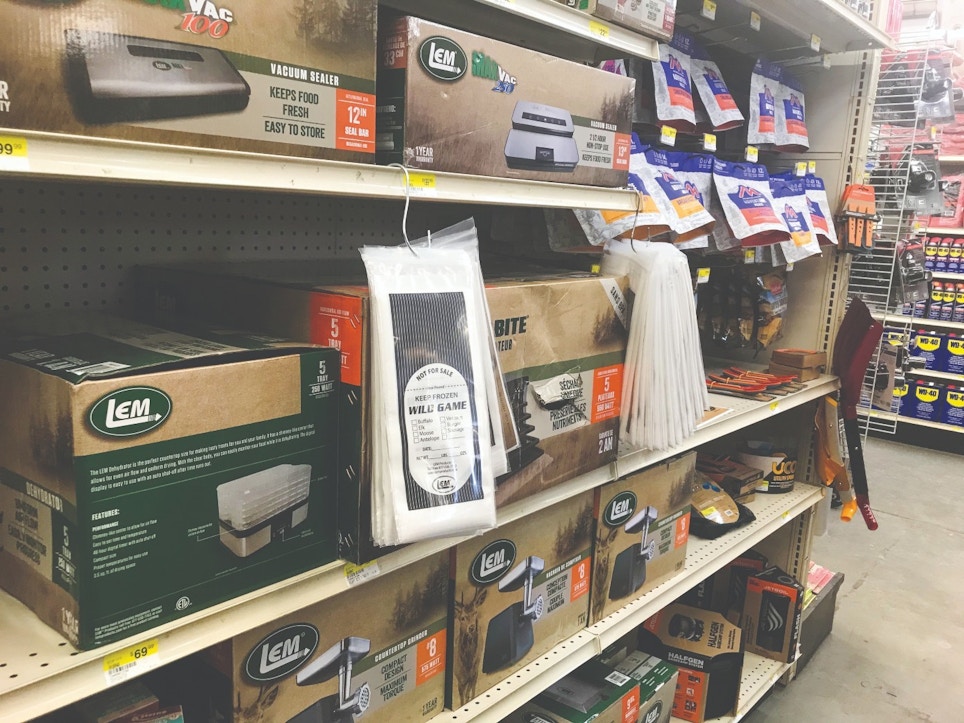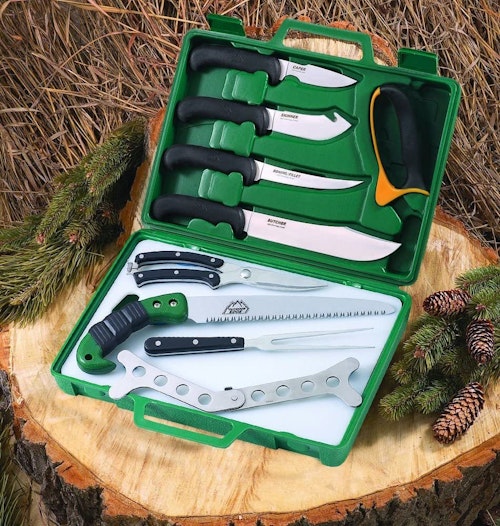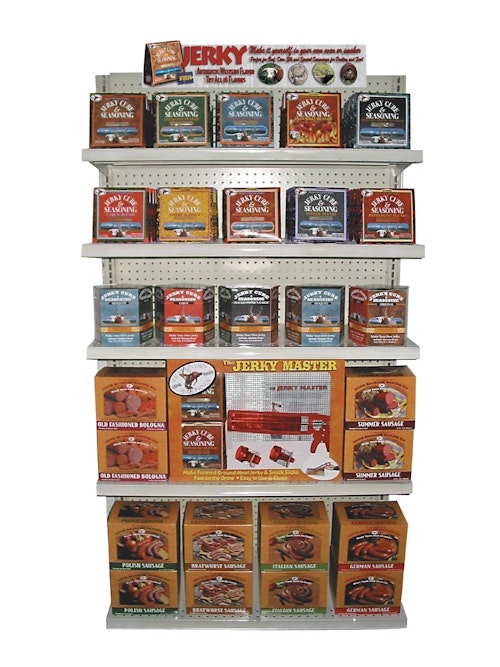Most hunting retail stores focus on getting their customers from Point A to Point B as hunters — that is help and guidance in buying a rifle, camouflaged clothing, and the ammunition, or possibly bow and arrows, to start hunting. That’s Point A. Then other gear and accessories the retailer offers help that hunter find success while on the hunt, such as treestands and rangefinders — reaching Point B. Your customers have gone hunting, bagged a big buck, bull or bruin, and now they head for Point C — follow-up when they are field-dressing carcasses, transporting the game meat, engaging in meat processing at home and finally reaching wild game storage and/or cooking. Are you serving your customers’ needs in that Point C after-success period?
While all retailers know firearms, ammunition, riflescopes and skinning knives are the basic staples that can be sold to hunters before they head afield, there is a huge market of goods for hunters when they return — if they find success afield. This is another opportunity to bring them back into your store if you have the many items those successful hunters need. Are you serving this after-the-hunt market?
The best way to think of this gear-heavy market is in three segments: In the field, on the move and on the road, and at home. Each is a unique period, each presents different challenges for hunters, and each requires specific gear. If you are not offering these items, many of your top customers are making several stops in hardware stores, grocery stores, and your competitors, to find this wide range of gear and processing equipment. These are hands-on items that sell if you have them and beat out the internet routes.
Since most states have laws against wasting game, you can help your customers. Remember that there are more than deer to be processed, so don’t overlook birds, small-game animals and other big-game animals. Each presents a unique challenge and a unique processing need. First, look at your region and the game hunters pursue, and then also think about those customers who travel to hunt and the game they mentioned hunting and bringing back home. This is a strong market that should never be ignored or you risk losing sales and income. The recent strong interest in organic meat and hunting has made after-the-hunt gear a bigger market — much bigger!
Divide Your Displays
You could consider making sections of your store into special after-the-hunt gear displays each fall and winter so shoppers can find everything they need while looking at one specific wall or row of shelving. Include some tasteful photos of successful hunters so your customers can picture themselves with a trophy or animal and realize they need to be prepared.
“We know the powerful impact visual merchandising has and how it leads to higher conversions,” says Will Morgan, Outdoor Edge Marketing Director. “Our game processing kits have tremendous opportunity (for sales) when it comes to display concepts, given the array of pricing and size of each pack. The ability to arrange the smaller kits such as the WildPak and JaegerPak on either side our larger GamePro helps draw the customers’ attention to these particular products.” Morgan suggests creating a pyramid look and offering different price points and options of knives and tools for game processing.
“Whether you are an avid hunter who processes several big-game animals each year or a new hunter just grasping the field-to-freezer concept, which is more important than ever with the increase in people partaking in outdoor activities, we have you covered,” continued Morgan. “We offer your customers game processing sets for all skill levels and budgets, which makes for easy conversations.” Some of these kits meet the in-the-field needs and the at-home processing needs of your customers.
The Animal Drops In the Field
This is a critical period when game must be reduced to segments that are ready to move. Work to stock and call attention to skinning knives and saws, protective gloves, ropes and pulleys and other items that help with the on-the-ground first step in preparing and moving a game animal.
Remember also that mesh meat bags and tarps will sell if you have them. The smaller 5x7 and 8x10 tarps are easy to pack, and most big-game hunters can use one. Don’t forget one other item nearly every hunter has in their daypack — a roll of orange tape. Ribbons of this hung in the display will definitely catch the attention of anyone shopping in your store.
Hunter and Game on the Move
The next step for your customer in Point C is moving the meat — sometimes a seeming mountain of meat. This can range from dropping game birds into a cooler to dropping an elk quarter onto the tailgate of their pickup. Grabbing and dragging is not the best option here, so offer solutions to ease the move burden, and your customers will buy them.
Here the list of goods to stock and showcase includes game carts with wheels, pack-frames with sturdy shoulder straps and waist belt, drag systems, and sturdy lifts and winches to lift game into vehicles’ cargo areas. Some of these items are hands-on, sell-themselves products if you have the product on the showroom floor so the customer can see how it operates. Check with manufacturers and suppliers about display models or informative videos you can play so customers understand how something works.
Hard-sided coolers have become a big market, and customers have become educated that top-tier coolers are sturdy and last a long time. Those don’t have to be camouflaged to catch hunters’ attention, but the coolers do have to be out of the box to get noticed. Be certain you and your staff can discuss handles, hinges, drains, insulation wall thickness, capacity and other details, because this product price point can range from about $50 to $500 and up. Companies such as RUGID can help you and your staff understand coolers and be prepared with answers. Customers will want to know the difference, because at first glance, coolers can all look the same — like a large box. Also, some premium coolers, such as Grizzly coolers, can be used to age meat before processing, and the company’s website gives full details. Customers will enjoy learning about this benefit.
These type items sell well if you call attention to them in the Labor Day through Christmas sales period.
Arriving at Home
The growing organic foods and meats movement has created a large customer base who knows where meat comes from and how to prepare it for the plate or freezer. Their needs for safely processing, packaging and freezing or drying meat are not being fully met by local grocery stores, hardware stores or the national big-box chains.
While freezer paper and tape might be at the local grocery store, and many hunters will still use them, these seem to be the old way. Today it’s clear plastic food bags and the button-operated units to cut and seal those bags. Cutting blocks, trays for meat handling, jerky guns, dehydrators and specialty knives are used — and sold, if you have them.
Next comes the final-final step, where seasonings, Dutch ovens, frying pans, grills, smokers and various kitchen and cooking utensils are needed by customers — it’s time to eat. Grilling and cooking wares is a mega industry.
“If you see a customer prepping for his or her hunt, buying ammo, extra socks, whatever, ask them if they need processing kits and seasoning for after the harvest,” suggests Hans Hummel with Hi Mountain Seasonings. “We suggest placing our easy-to-use jerky and sausage making kits (which see a lot of fall/winter movement) along with our extensive line of shaker-bottle seasonings, which sell year-round.” Hummel indicates some retailers place those items in the camping area, while other retailers create areas devoted entirely to game processing.
Another growing after-hunting-success category are lifestyle goods. Silverware and plates with an outdoor theme will draw attention and ring your register if you have them displayed. Don’t forget drinkware, and note some cooler companies offer a wide range of these products. If you are not selling these, your customers are buying them elsewhere. These are a see-it, buy-it product with hunters across America.
Just before spring arrives and attentions turn to turkey hunting, consider an end-of-season sale where you showcase these items and attach price tags that bring customers shopping — and buying.








